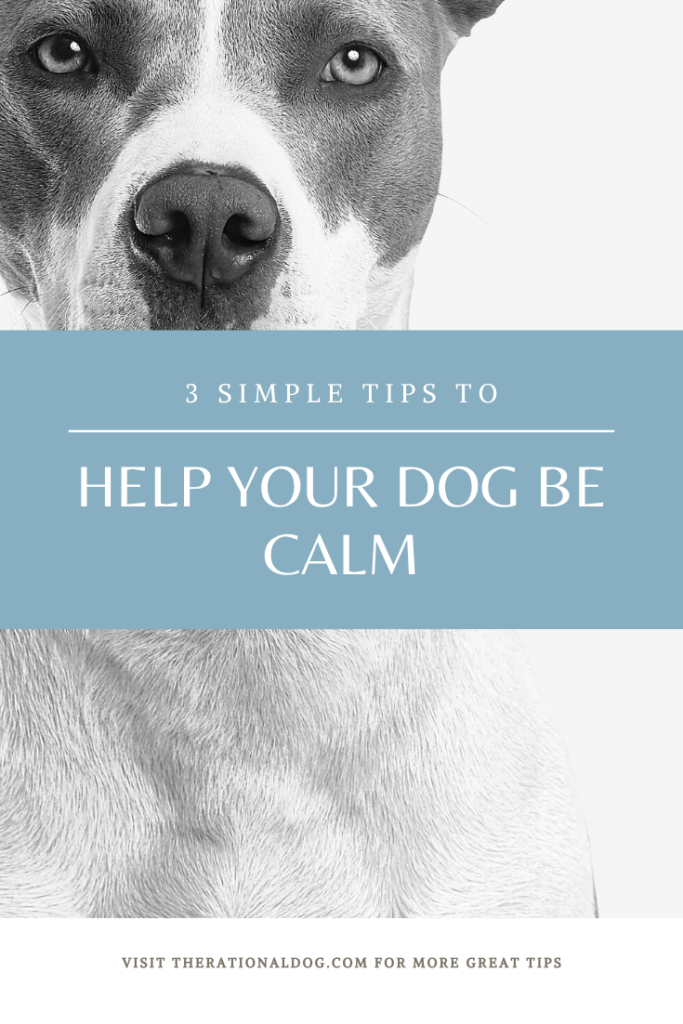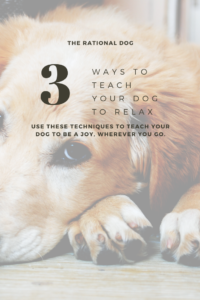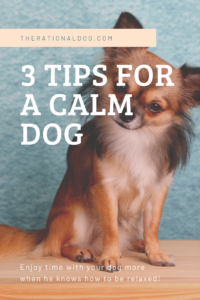When folks ask me training questions about training their dogs to be an awesome family companion, or dealing with a difficult training problem, something related to over-excitement is usually the underlying concern. Their dog jumps because he’s excited. He barks and races around the house because he’s excited. He steals toys or food and won’t give them back because…you guessed it, he’s over-excited.

Having a dog that knows how to be calm and relaxed in the house is essential for having a house free from canine-induced chaos. As someone who lives with multiple dogs in my home myself, I can attest to the fact that relaxation and learning to be still are keys to avoiding constantly correcting your dog.
And for those folks who don’t think it’s possible to teach a dog to be calm, still, and relaxed on command, I say to you that IT IS! And teaching this skill is incredibly valuable to every dog who is part of society today. It’s a game-changer for dogs that want to be a part of their owners’ everyday lives because it means that they will be welcome along on trips, eating on restaurant patios, and so much more.
Why is my dog over-excited?
So let’s start with the root of the problem. Why could your dog be so excitable in the first place? There are many reasons, but it’s usually one of the following that is the culprit:
- Your dog is young and lacks impulse control. This isn’t to say that only young dogs lack impulse control, or that all young dogs fall on the spectrum of over-excitement. However, many young dogs (under 2 years old) are filled to the brim with youthful vigor and don’t have appropriate outlets for that energy. Providing your dog with training and consistent expectations will do wonders for the vibrant young dog!
- Your dog does not know how to NOT be busy. Many dogs have simply never been taught the skill of being still. They pace, they wander, they run, they race, and they go, go, go until they can’t go anymore. Simply learning to stop moving all the time will be an incredible help to these dogs.
- Your dog is an adrenaline junkie. No, this is a real thing, though it’s not technically just adrenaline that is the culprit. Some dogs get so used to the feeling of being pumped up with excitatory neurochemicals that they start to seek out ways to get themselves over-excited, even to the point of engaging in aggressive or destructive behaviors. These are the dogs that charge to the end of the leash barking like madmen, race up and down their fences when they see a squirrel, or destroy doors and furniture when left by themselves. The skills outlined in this post will certainly help these dogs, but they need a much more pointed and specific training approach to address these challenges.

So let’s dive in a little bit into how to teach your dog to be a calm, relaxed companion. Our main goal is to have a dog that isn’t blasting around the house like a rocket, knocking over small children and smashing lamps in the process. We want someone who is able to lie calmly at your feet at home, or out in public. Here are 3 ways to teach your dog to relax.
Conditioned Relaxation
Conditioned Relaxation has been touched on in a couple of my other posts, and there’s a reason for it. It’s my very favorite method for teaching a dog to relax on command, it’s incredibly effective, and there is no limit to how this skill can be used.
The name pretty much speaks for itself – Conditioned, meaning “taught,” and Relaxation, meaning, well…relaxation. Teaching a dog to understand how to attain the feeling of relaxation on his own, and choosing to do it over the wild excitement of living the busy life. Conditioned Relaxation is a key part of Syn Alia Training Systems (which I go into more depth in this post about), and is all about helping the dog be calm enough to think rationally when confronted with stressful or exciting triggers.
Conditioned Relaxation is taught using a mix of massage, touch techniques, name and explain, and reinforcing relaxation.
Sit on the Dog
No, this is not actually about sitting on your dog! It is a technique developed by Margo Woods, and it is deceptively easy to do. The purpose is to teach your dog to be calm and still beside you in the down position. It teaches an exuberant dog how to not pop up every few seconds, and is an invaluable exercise for when you are out in public and need your dog to lie quietly beside you.
To do this exercise, simply have a seat, and have your dog on the leash. Tell your dog to lie down, and put your foot on the leash. You want to give the dog enough slack that if he is in the down position beside you, he will have plenty of lead, but it will tighten up if he tries to stand, sit, or move around. If your dog tries to jump up, roll over, or otherwise has a fit about being asked to lie still for more than two seconds, that’s fine. Hold your ground and keep your foot on the leash. Your dog will tire of the temper tantrum fairly quickly, and will relax beside you. When that happens, give your dog lots of praise and treats, but don’t let them hop up again just yet. Keep them in that down position for a little while, until YOU are ready to get up and move around.
It may get exciting the first time or two that you do this exercise, but once your dog understands the gist of what you’re doing, they should melt to the floor and be calm as soon as you put the leash on the floor to put your foot on it. Before long, you won’t even need the leash on, and your dog will settle beside you out of habit.
I always start this exercise at home during a stationary time – reading a book, watching TV, or eating at a table are all great times to have your dog practice lying quietly beside you. Once you have mastered it at home with few distractions, then you can take it on the road and start adding more and more distractions, such as going to a park bench, lying beside you on a restaurant patio, or waiting at the register at Home Depot.
Place Training
Place training is very similar to teaching your dog to lie at your feet. The big difference is that you’re teaching your dog to relax in a specific, designated spot. Their “Place.” That place could be their bed, a mat, a crate, the couch, really the sky is the limit. However, you’re teaching your dog to go to their place and stay there, relaxing, until released. This exercise or command works great in conjunction with both Conditioned Relaxation and Sit on the Dog, but it also adds an element of your dog not needing to be right beside you at all times in order to be calm and relaxed.

Why your dog needs to relax.
Now for the tough part. I’m sure that after reading this post, you can imagine how nice it would be to have a dog that knows how to relax at your feet or who can go lie down independently on his bed when you tell him to. It’s definitely a relief, especially when you have had a dog whose manic energy or over-excitement has run unchecked through your house for who knows how long.
In addition to that, dogs that live their lives in a constant state of stress tend to be both mentally and physically unhealthy, and do not live as long as those who have some relaxation experience. It is also extremely helpful to have a dog who knows how to relax on command when you encounter something new and scary out in the big, wide world. Just as we can teach coping skills to children to help them not to be afraid or worried around new things, so we can teach dogs with these skills!